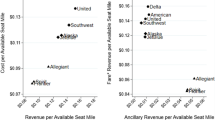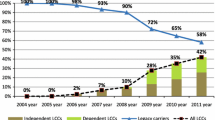Abstract
We use T-100 traffic data and DB1B fare data from the U.S. Department of Transportation to identify patterns and effects of entry by network carriers and low-cost carriers in non-stop U.S. airline markets. For the sample period from 1996 to 2009, we find that entry activity of low-cost carriers did not only experience significant absolute increases but also led to substantial fare reductions. As route entries by network carriers do not have comparable effects, the existence and expansion of low-cost carriers must be considered as the main driver of competition in the domestic U.S. airline industry.






Similar content being viewed by others
Notes
The following carriers are classified as LCCs: Southwest Airlines, AirTran Airways, JetBlue Airways, Allegiant Air, Frontier Airlines, Spirit Airlines, Sun Country Airlines and Virgin America. All other (non-regional) airlines in the T-100 Domestic Segment database were classified as NWCs. The group of NWCs is typically supported by a larger group of regional airlines. Most of those smaller airlines operate in small feeder traffic markets and often assist one particular network carrier in the operation of its hub-and-spoke network. Although most of these regional carriers are legally independent, their economic existence is often tied to a large network carrier. For example, in most instances, regional carriers do not issue their own tickets but refer to the network carrier for all flight bookings. In the empirical analysis of entry patterns and effects of entry, regional airlines are excluded from the analysis.
Although there are good reasons for applying both market delineation concepts—airport-pairs and city-pairs—we follow the more conservative approach of airport-pairs. Every effect found on an airport-pair level is expected to be even more pronounced on a city-pair level. For a detailed discussion of airport-pairs vs. city-pairs, see Brueckner et al. (2010).
Although the focus of this article is on the role of market entry, there is no doubt that market exit can be a closely related phenomenon. For example, entry into one market can demand exit in another market as, e.g., a particular airplane can be operated more efficiently on the new route. Furthermore, any reorganisation of the flight network typically triggers waves of entry and exit. For example, airline mergers often lead to market exits either through the elimination of overlapping parts of both networks or by the decommissioning of entire hubs of one of the merging airlines.
The calculation and interpretation of survival rates offers various degrees of freedom. With respect to calculation, Bamberger and Carlton (2006), for example, decided to count an entry as ‘survived’ if the airline was still active on the respective route one year after entry. Consequently, they find on average higher survival rates than reported in Fig. 2 (based on a ‘two-year’ definition of survival). With respect to interpretation, the general results reported in Fig. 2 could be specified by analysing survival rates for specific carriers or even specific route types of specific carriers (e.g., routes to/from their respective hubs versus other routes).
The number of departures can also be interpreted as a measure of quality as—with a growing number of departures—the traveller has more choices between different travel times over the day and is therefore able to reach a better fit of the transportation needs with the general work (or leisure) schedule.
It is important to remind at this point that our analysis concentrates on the effects of entry in existing markets only. Any study that aims at calculating the entire (consumer) welfare effect of entry, however, has to include the (consumer) welfare created by entry into new markets (i.e., markets which did not have a direct connection prior to the entry of a specific carrier).
In the sample period, on average, 64% of all U.S. domestic passengers travelled in the TOP 500 markets.
For each carrier, we investigate those markets i in which the carrier actually entered between 1996 and 2009.
The post-deregulation era has seen several attempts by network carriers to launch their own low-cost carriers. For example, Delta founded Delta Express in 1996. The airline operated a hub at Orlando airport and focused particularly on leisure routes. In order to be able to compete on price, Delta Express’ fleet consisted of only one aircraft type with an all coach class configuration. No in-flight entertainment or meal service was offered. Delta Express ceased operations in 2003 and was replaced by Song as the new low-fare brand of Delta. Song, however, ceased operations in 2006 and was reintegrated into its parent company. Comparably unsuccessful launches of low-fare brands were experienced by United (Ted, 2004–2009) and US Airways (MetroJet, 1998–2001). From an analytical perspective, T-100 data does not provide an easy solution to separate between entries of the respective network carrier and entries by its respective low-cost branch as the respective airline codes for both carriers are identical. However, the length and breadth of our data set together with the rather short, rather small and rather unsuccessful low-cost endeavours of the network carriers make it unlikely that they affect our results to a larger degree.
For example, between 2000 and 2009, JetBlue entered 131 domestic markets. On average, 40% of all entries created new routes, with 14% in 2005 and 83% in 2002 delineating the spectrum. However, despite the significance of entry into new markets, in 2009, only 30% of the 20 million JetBlue passengers traveled in new markets while the remaining 70% flew in existing markets.
An example for such an increase in the likelihood of entry could be the announcement of Southwest or JetBlue to include a new airport into their route network. Given the (partly sunk) investments in new airport presence together with the possibilities to exploit network economies makes it very likely that the respective carrier will extent its number of connections from the respective airport.
One example of such fierce competitive interaction was JetBlue and Song (the former low-fare brand of Delta) on flights to Florida (which both carriers picked as key region in their respective entry strategies).
References
Bamberger G, Carlton D (2006) Predation and the entry and exit of low-fare carriers. In: Lee D (ed) Advances in airline economics vol. 1. Competition Policy and Antitrust, Amsterdam, pp 1–23
Berry S (1992) Estimation of a model of entry in the airline industry. Econometrica 60:889–917
Boguslaski R, Ito H, Lee D (2004) Entry patterns in the Southwest Airlines route system. Rev Ind Organ 25:317–350
Brueckner J, Lee D, Singer E (2011) Airline competition and domestic U.S. airfares: a comprehensive reappraisal. Working Paper University of California, Irvine
Brueckner J, Lee D, Singer E (2010) City-pairs vs. Airport-pairs: a market-definition methodology for the airline industry. Working Paper University of California, Irvine
Ciliberto F, Tamer E (2009) Market structure and multiple equilibria in airline markets. Econometrica 77:1791–1828
Daraban B, Fournier G (2008) Incumbent responses to low-cost airline entry and exit: a spatial autoregressive panel data analysis. Res Transp Econ 24:15–24
Dresner M, Windle R (2000) Assessing competitive behavior by US air carriers. Transp Q 54:177–189
Dresner M, Lin J-S, Windle R (1996) The impact of low cost carriers on airport and route competition. Journal of Transport Economics and Policy 30:309–328
Dunn A (2008) Do low-quality products affect high-quality entry? multi-product firms and nonstop entry in airline markets. Int J Ind Organ 26:1074–1089
Geroski P (1995) What do we know about entry? Int J Ind Organ 13:421–440
Geroski P (1991) Market dynamics and entry, Oxford
Goolsbee A, Syverson C (2008) How do incumbents respond to the threat of entry? evidence from the major airlines. Q J Econ 123:1611–1633
Ito H, Lee D (2004) Incumbent responses to lower cost entry: Evidence from the US airline industry. Working Paper, Cambridge
Joskow A, Werden G, Johnson R (1994) Entry, exit, and performance in airline markets. Int J Ind Organ 12:457–471
Lederman M, Januszewski S (2003) Entry patterns of low-cost airlines. Working Paper, Cambridge
Lin J-S, Dresner M, Windle R (2002) Determinants of price reactions to entry in the US airline industry. Transp J 41:5–22
Morrison S (2001) Actual, adjacent and potential competition: estimating the full effect of Southwest Airlines. Journal of Transport Economics and Policy 35:239–256
Sinclair R (1995) An empirical model of entry and exit in airline markets. Rev Ind Organ 10:541–557
US Department of Transportation (1997) The low cost airline service revolution, Washington DC
Whinston M, Collins S (1992) Entry and competitive structure in deregulated airline markets: an event study analysis of People Express. RAND J Econ 23:445–462
Windle R, Dresner M (1995) The short and long run effects of entry on US domestic air routes. Transp J 35:14–25
Acknowledgments
We would like to thank three anonymous referees and the audiences at the 2011 ATRS Annual Conference in Sydney, the 2011 GARS Workshop in Melbourne and seminars in Auckland, Nice and Sydney for very valuable comments and suggestions which substantially improved the article. We are especially indebted to Volodymyr Bilotkach for his advice during the construction of the data set.
Author information
Authors and Affiliations
Corresponding author
Appendix
Appendix
Tables 3, 4, 5, 6, 7, 8, 9, 10, 11 and 12
Rights and permissions
About this article
Cite this article
Hüschelrath, K., Müller, K. Patterns and Effects of Entry in U.S. Airline Markets. J Ind Compet Trade 13, 221–253 (2013). https://doi.org/10.1007/s10842-011-0115-4
Received:
Revised:
Accepted:
Published:
Issue Date:
DOI: https://doi.org/10.1007/s10842-011-0115-4




